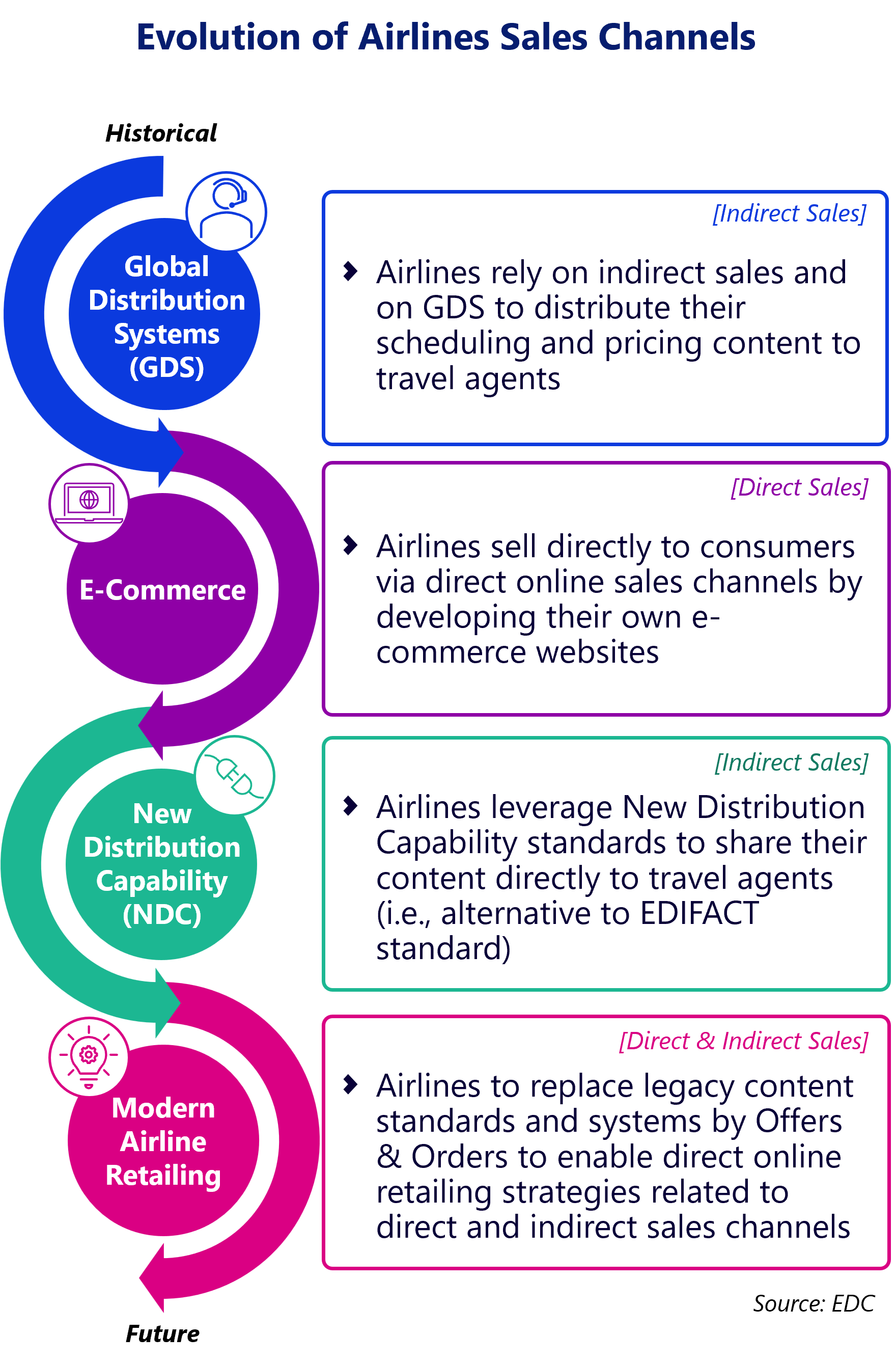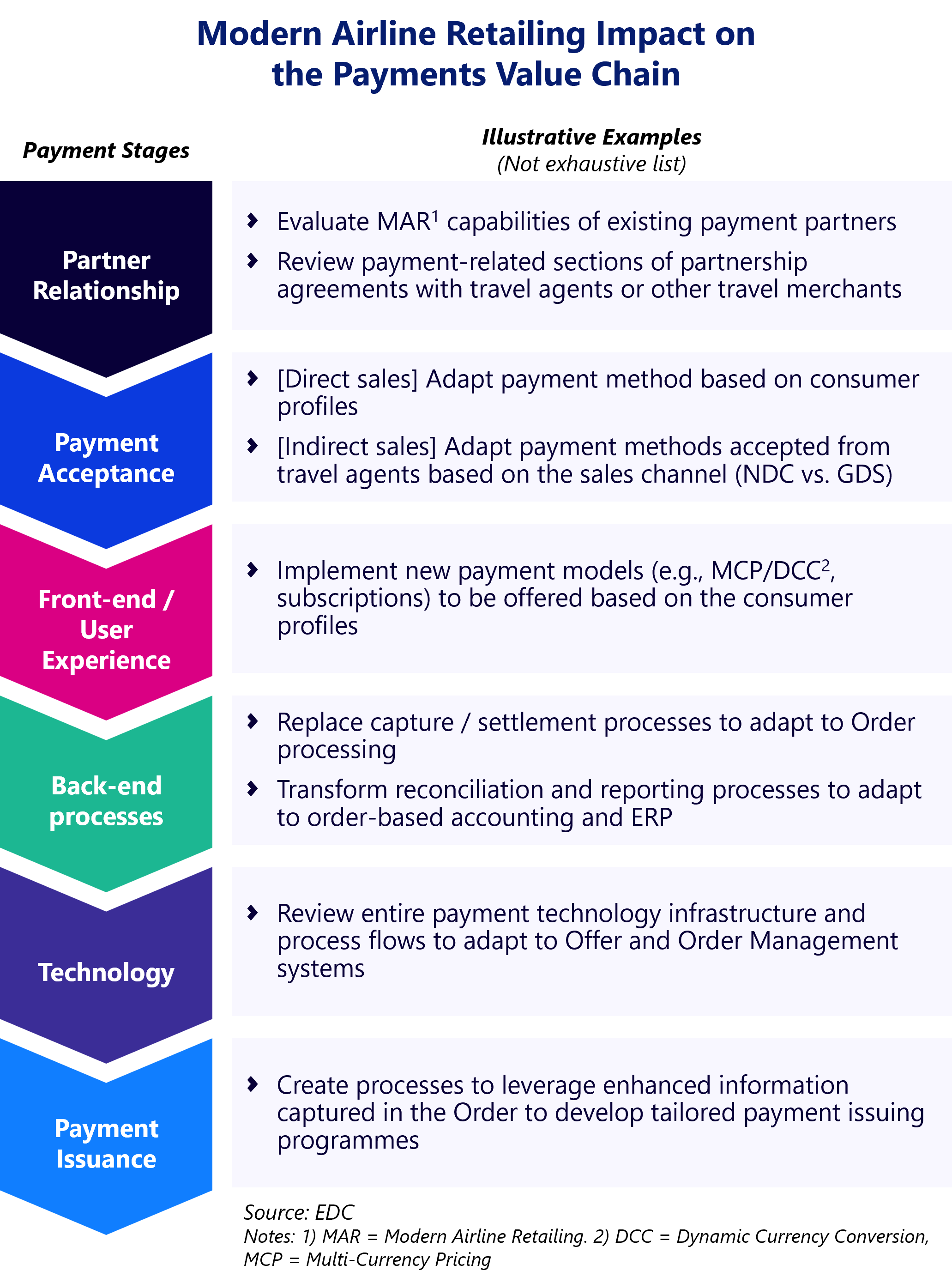Modern Airline Retailing driving the next industry transformation
The complex and unique nature of the airline business (e.g., pricing structures, booking processes, different types of intermediaries, ticketing, etc.) led to complex distribution and payment processes. This has historically conditioned airlines’ commercialisation strategies, including payments, slowing down their innovation and creating significant differences compared to other e-commerce retailers.
For the past two decades, e-commerce retailers have focused on creating omni-channel strategies placing customers at the centre of their ecosystem and defining optimal user experiences. These e-commerce retailers have followed the same approach to define their payment strategies. Meanwhile, airlines typically lagged behind other industries, with the constraints of legacy systems and processes.
However, in recent years, the “Modern Airline Retailing” framework, promoted by IATA, is encouraging airlines to adopt initiatives to increase airlines’ control and flexibility in their distribution channels, allowing them to adopt customer-centric distribution and payment strategies. Within this framework, IATA has developed initiatives such as New Distribution Capability (NDC) and Offers & Orders standards.
Leveraging the NDC standard, airlines can distribute content/product propositions (e.g., fares, ancillaries, bundles) directly to travel agents by using APIs, as alternative to the EDIFACT standard used in sales distributed by Global Distribution Systems (GDS). Meanwhile, as a result of the Offers & Orders standards, airlines are expected to directly create customised, dynamic product propositions, offered to customers in real-time based on their profile (referred as “Offer”) and move to a single record that captures the customer’s purchase, fulfilment, and servicing information (referred as “Order”), replacing existing Passenger Name Records (PNRs), E-Tickets (ETs), and Electronic Miscellaneous Documents (EMDs).
Industry estimates are that 81% of airlines were live with NDC as of November 2024. In many cases, NDC has been the first step towards a broader Offers & Orders transformation. In May 2025, Finnair became the first airline to go live with the first “native Order”, leading the technology transformation. Other advanced airlines are expected to be ready to start processing Orders in 2026.

Despite these initiatives being originally developed from a distribution perspective, their implementation has significant impact on airlines’ payments strategy, for both consumer (C2B) and business (B2B) payments. As airlines take more ownership of their distribution channels, they need to carefully assess which payment models are most suitable to reduce costs, while optimizing revenues. Embracing the Offers & Orders initiative will also require airlines to undertake a significant IT transformation to gradually switchover from legacy systems to product, offer and order management systems, impacting the entire payment technology infrastructure and back-office processes.
The ripple effect on airline payments
Modern Airline Retailing is being implemented as a distribution-first initiative but has also major impacts on payments. Based on EDC’s experience, many airlines have not yet defined the future state and transition approach for payment processes.
The implementation of NDC has been a clear example of this trend. EDC has encountered multiple airlines that implemented NDC as a new channel for indirect sales (either directly or via an NDC aggregator), without considering the payment process implications or asking themselves questions such as:
- Who is the merchant of record (MoR)?
- Who manages the authentication, the authorisation and the capture / settlement steps?
- Who manages the payment reporting to travel agents?
- If the travel agent is the MoR, how does the airline receive the funds?
As a result, many airlines have adopted a new distribution channel but inherited the same-old legacy payment processes or rushed into sub-optimal payment situations.
To develop a payment strategy that matches their Modern Airline Retailing ambitions, airlines need to understand the implications of these initiatives across the entire payment value chain.

Planning for change and building a future-ready payment strategy
Implementing Modern Airline Retailing initiatives is a complex undertaking that requires considerable time and resources. Accordingly, airlines must meticulously define their strategic implementation plan and roadmap including payments. Based on Edgar, Dunn & Company’s expertise, there are five key steps for airlines to consider:
- Set a clear end vision: Airlines must define what are their final strategic objective as well as achievable interim targets (including payment KPIs) based on their current situation
- Plan ahead: Airlines aiming to implement initiatives such as Offers & Orders within the next five years should incorporate them into their multi-year payment strategy now, ensuring sufficient time to address the associated complexity and implementation timeline
- Assess impacts thoroughly: To holistically plan for these core changes, airlines should conduct a detailed payment-related impact assessment to anticipate the required changes (e.g., need for new payment vendors, renegotiate payment contracts, redesign payment flows including back-office functions such as reconciliation)
- Secure long-term sustainability: If an airline is committed to adopting Modern Airline Retailing initiatives, all subsequent strategic decisions related to payments should be aligned to ensure long-term compatibility with a future Offers & Orders environment
- Align internal organisation: The framework allows airlines to create payment strategies aligned with retailing and distribution objectives. Achieving this will require close coordination among internal teams such as payments, commercial, IT, and finance.
Ambitious transformation is gathering momentum in the airline payment industry, aiming for airlines to become mature retailers, fully in control of their distribution and payments processes. To stay ahead and be ready for what is to come, airlines must begin planning now by developing a future-ready payment strategy.
Edgar, Dunn & Company’s (EDC’s) Travel Payments Practice have compiled the seven articles of the series “From Plumbing to Shopfront: How “Payments” is Changing for Airlines” into a whitepaper, which can be downloaded HERE.
For further details or inquiries about the report, please contact us at travelpayments@edgardunn.com
The content of this article does not reflect the official opinion of Edgar, Dunn & Company. The information and views expressed in this publication belong solely to the author(s).
Julia is a Manager based in EDC’s Paris office with over 6 years of strategy consulting experience within payments and financial services in several European, North American, Latin American and Middle Eastern markets. She has developed valuable expertise by working with a wide variety of clients across the payments value chain (e.g. central banks, issuers, acquirers, payment schemes, merchants and payment providers) with a larger focus on retail and travel verticals. Julia holds a BSc in Business Management from the Complutense University of Madrid and an MSc in Professional Development from the University of Alcalá. Outside of work, Julia likes to read and plays tag rugby.
.webp)
%20(1).webp)

%20(1).webp)

.webp)
.webp)

